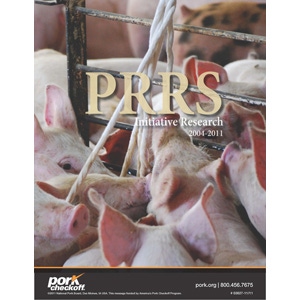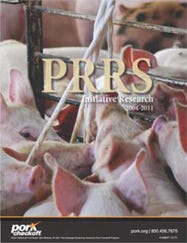January 9, 2012

While porcine reproductive and respiratory syndrome (PRRS) is a formidable and costly enemy to fight, extensive research funded by the Pork Checkoff is helping the pork industry gain ground in the battle against this tenacious virus.
“The Pork Checkoff is committed to finding practical solutions to this very complex disease through investments in research,” says National Pork Board President Everett Forkner, who notes that the Checkoff recently mailed producers a copy of the 40-page PRRS Initiative Research 2004-2011 report. “Whether it’s looking at the real-time challenges, such as the implementation of regional elimination, or long-term issues, such as determining genetic resistance to PRRS, Checkoff is involved on the frontlines of research on producers’ behalf.”
PRRS has been a challenge for producers since the late 1980s and remains one of the most costly diseases that producers face. In a recent Checkoff-funded economic assessment, PRRS has been shown to cost the industry more than $664 million a year, which translates to nearly $115/sow.
 The PRRS Initiative Research 2004-2011 report offers a comprehensive reference on the evolution of PRRS research and can help with the development of herd health management strategies, says Lisa Becton, DVM, director of swine health information and research for the Pork Checkoff.
The PRRS Initiative Research 2004-2011 report offers a comprehensive reference on the evolution of PRRS research and can help with the development of herd health management strategies, says Lisa Becton, DVM, director of swine health information and research for the Pork Checkoff.
“Thanks to the breadth of the research that has been gathered in recent years, our understanding of PRRS is increasing by leaps and bounds,” says Becton, who notes that the PRRS Initiative Research program supported by the Pork Checkoff’s Swine Health Committee has funded 123 projects totaling more than $10 million since 2004. “There are definite things producers can do to control PRRS from getting in their operation.”
Protecting Swine Health
The PRRS Initiative Research 2004-2011 report addresses five key areas, including:
1. Immunology and vaccine development. This section focuses on creating alternative approaches for vaccine development and improving herd health management in herds with multiple health challenges.
2. Epidemiology, risk factors and control strategies.This section offers biosecurity tips to help control PRRS, such as using air filtration to prevent PRRS infection.
3. Diagnostic tests and PRRS surveillance.Becton notes that researchers have made great strides in detecting new and emerging strains of PRRS virus, such as simpler methods of PRRS sample collection and improved diagnostics that provide faster results.
4. Regional elimination.Controlling PRRS begins with proven biosecurity basics starting with the Production Animal Disease Risk Assessment Program (PADRAP) risk-assessment program, which helps producers identify their potential risk for getting a disease in their swine herd. This section of the report also addresses the development of a standardized geographical mapping program for herd status.
5. Genetic resistance to disease.Researchers have made a number of advancements in the discovery and verification of genotypes and phenotypes that can predict susceptibility and/or resistance to PRRS infection. The report highlights the ongoing and broad collaboration between researchers from multiple universities, government, pig breeding companies and other organizations who are studying the genetics of disease resistance and overall pig health.
“While we’re learning a great deal about how the virus operates within the body and evades the immune system, there’s still a great deal more that needs to be studied,” Becton says. “The Pork Checkoff’s continued investments in PRRS research will be critical for managing this disease.”
You May Also Like



